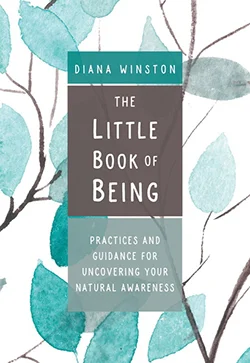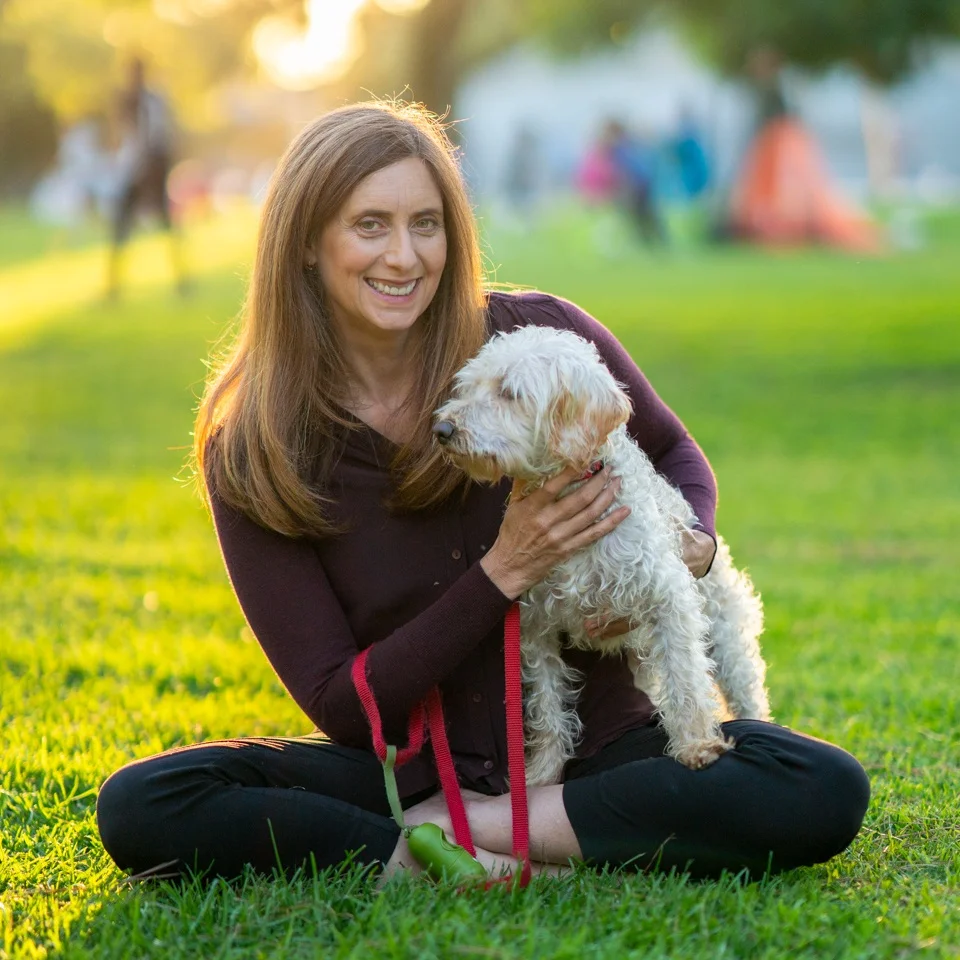Meet Diana Winston, and read an excerpt from “The Little Book of Being”
Interviewed by Marlena Trafas
what is natural awareness?
(an excerpt from “The Little Book of Being”)
Awareness is a capacity of the human mind. Awareness is the ability to directly know and to perceive, sense, feel, or be cognizant of experience. We might think of awareness simply as the state of being conscious of something.
Every living being is aware. We usually don’t think much about awareness, but in order to function, humans have to be aware. Not only do humans have the capacity to be aware, but they also have the ability to be aware of awareness, or aware that they are aware. Let’s try this simple experiment:
Right now, put down the book and don’t be aware. In the next minute, please stop being aware. I mean it. Ready, go . . .
Are you back? Could you not be aware? No, you couldn’t. This capacity to be aware is a function of the human mind. And in this exercise, you noticed that you were aware and that it’s impossible to stop being aware.
However, being aware is not natural awareness. Natural awareness is very hard to explain (and that’s why it takes me the next 208 pages!), but here’s the synopsis: Natural awareness is a way of knowing and a state of being wherein our focus is on the awareness itself rather than on the things we are aware of. It is generally relaxed, effortless, and spacious.
Natural awareness can subjectively feel very powerful. It can feel like a deep sense of peace, joy, love, contentment, serenity, connection, and much more. It can be evoked through specific practices, and it is a type of meditation in and of itself. It can become a familiar state, accessible in daily life and regularly experienced as you meditate with it over time.
Editor’s note
Diana Winston has been practicing meditation since 1989 and spent a year in Burma as a Buddhist nun. She began teaching mindfulness in 1993 and has taught in hospitals, universities, corporate offices, nonprofits, and schools in the United States, Asia, and online. She developed the evidence-based Mindful Awareness Practices (MAPS) curriculum and the Training in Mindfulness Facilitation for mindfulness teachers to use and share worldwide.
Diana first taught at UCLA in 2005 and now serves as the director of Mindfulness Education at the Semel Institute’s Mindful Awareness Research Center (MARC). She coauthored, with Dr. Susan Smalley, Fully Present: The Science, Art, and Practice of Mindfulness. Below, she discusses natural awareness, digital distractions, and finding quiet moments amidst busyness.
“Natural awareness” is a fairly abstract concept. Can you speak to the first time you felt naturally aware and how you were able to translate that awareness into other, more mundane, aspects of your life?
Natural awareness is the term I use that points us to the expansive, spacious, and effortless side of mindfulness. All of us have the capacity to be aware, and many of us have had access to natural awareness without even calling it that. In my book I discuss being a teenager, sitting out under the stars and feeling a sense of connection, vastness, and love that spontaneously arose.
Any moment that we can settle back, be with what is, and rest our attention, whether it is when washing dishes, talking with a friend, or hiking in nature we can connect with this sense of well-being that is inside all of us. It is not something abstract.
You describe “natural awareness” as a state of being where, “Your mind is completely aware and undistracted without you doing anything in particular to make yourself aware; Your mind is like wide open space, and everything in it is just passing by.” This seems contradictory. How can everything pass into your mind without you becoming overwhelmed?
To answer this, I’ll describe an approach you can use in meditation: Imagine your mind is like the sky—vast and open. Now imagine that all the thoughts, emotions, and sensations are just like clouds floating by. Rather than trying to pay attention to every breath, thought, and so on as we might do in deliberate mindfulness, simply connect with the spacious quality of the sky, and let all the inner experiences pass by on their own. Relax, don’t try too hard.
In this way, with a light touch, practicing with natural awareness is not overwhelming. And if it does get overwhelming, then we simply return our attention to something that’s familiar and comfortable, such as our breathing. Once we feel solid and grounded, we can again experiment with this sky-like meditation.
Distraction is a big obstacle to natural awareness and 21st century technology makes it easier than ever to distract ourselves from looking inward and reflecting. As you say in the book, “Our devices in and of themselves aren’t necessarily inherently harmful, but most of us use them to check out of ourselves, rather than check in with ourselves.” Is it possible to use our devices more productively to aid our mindfulness practice? What might that look like?
Well there has been an explosion of mindfulness apps, recordings, videos, websites, and online courses available now for anyone to try. When I first started meditating this was unimaginable. Many of these are wonderful resources but there is no real quality control so it is hard to know which ones are useful and because there are so many, it’s also hard to know how to get started and which ones to choose.
So, technology can be used in the service of more awareness. People can learn more about meditation, practice with recorded meditations, practice with others, and receive teachings. These are wonderful uses of technology in the service of meditation. However, most of us spend our days distracting ourselves with our phone, so 30 minutes of an app doesn’t counteract the impact of 15 hours and 30 minutes of distracted phone use!
There’s this idea that to be a modern person in today’s world one must always be stressed out because stress is a sign of working hard. How do conventional ideas of success and hard work help or harm our ability to access natural awareness?
I do think the mainstream culture values success and productivity to an absurd extent. However, I don’t think it’s a coincidence that as the world seems more sped up, more demanding, more financially stressful, and so on, that mindfulness has gained so much popularity.
Additionally, I’ll speak personally here: I do think that when I get really busy it’s harder for me to access natural awareness. My mind is full of all of my duties, responsibilities, and to-do lists and they can take over my mind. That’s why when I get busy I have to be really rigorous with my daily practice—formally and informally.
But we also can learn to rest our mind in a place of ease even in the midst of the busyness. Sometimes it’s taking a pause where I do one of the Glimpse Practices that I share in my book. It might take just 10 seconds. Other times it’s about finding the place of ease even in the busyness—which is absolutely possible. A nice practice for when I’m on a deadline and my daughter is begging me for more sugar and my dog is chewing something up all simultaneously is to simply pause and say, “Is it okay to be with just this?” And often times I can. And when I can’t, here’s the tricky thing: I can be okay with not being okay with “just this.” You can chew over that one.
You mention that along with our “to-do” lists and our “should-do” lists, there’s also “a sprinkling of despair at the state of the world, economic uncertainty, environmental catastrophe,” that make it difficult to access our natural awareness. Obviously, the broader socio-political context greatly affects our thought processes because these are high-stake situations with real world consequences. Therefore, how does one acknowledge and be aware of the world’s problems while also being aware of themselves and their own awareness?
I do both. I practice internally, developing my own awareness and cultivating more and more states of well-being. This then impacts my relationships in my family and work, the students and the institutions that I am part of. And it also gears me up to face the suffering of the world. The qualities we cultivate in our inner life—like equanimity, patience, and compassion—can make us more effective to do the work of outer change. It would be ridiculous if we took some attitude like, “I’m so aware so it’s all good and therefore let’s just sit back and ignore the suffering of the world.” We can work on ourselves and work on the healing of the planet simultaneously.
GLIMPSE PRACTICE: RECOLLECTION
(a practice from “The Little Book of Being”)
One of the simplest ways to access natural awareness is through memory. Let yourself remember a time when you felt awake, connected, peaceful, expansive—in a state of “being-ness.” Recall this time. Don’t try too hard; let it come to you in a simple way.
Perhaps you were in nature, in the midst of athletic activity, in the creative flow, lying at rest in bed, with a lover, or laughing uproariously with your best friend. Can you remember where you were? What did you see? Hear? Now remember how you felt at the time. What did your body feel like? How about your heart? See if you can invite in a full-bodied experience of the memory. Recall details: sight, scents, sounds, and any other sensory experience.
Now notice what is happening in the present moment. See if a sense of being-ness is present for you, just by your imagining a past experience. What does that being-ness feel like? Connectedness, ease, presence, relaxation? Let yourself rest here.


